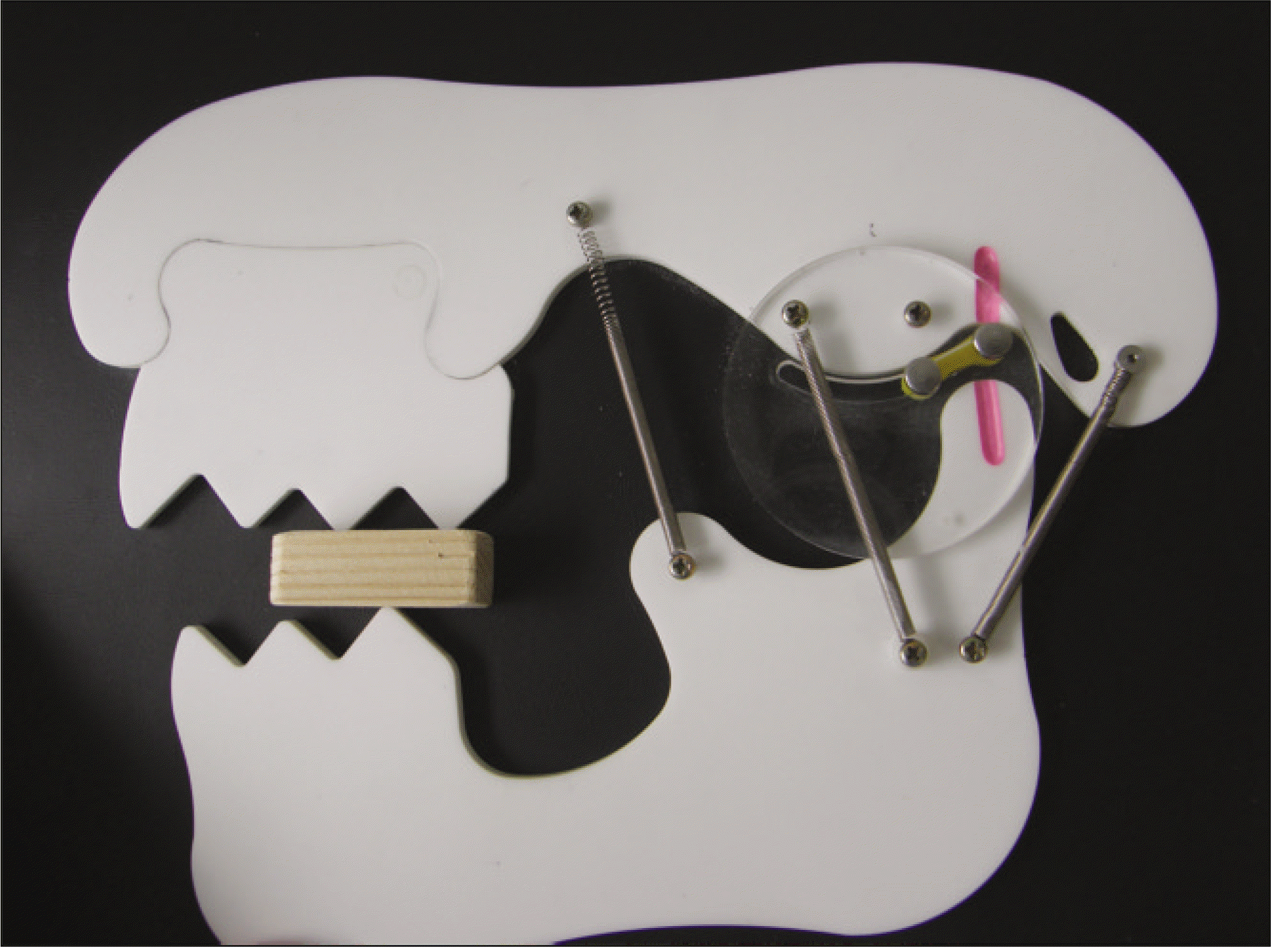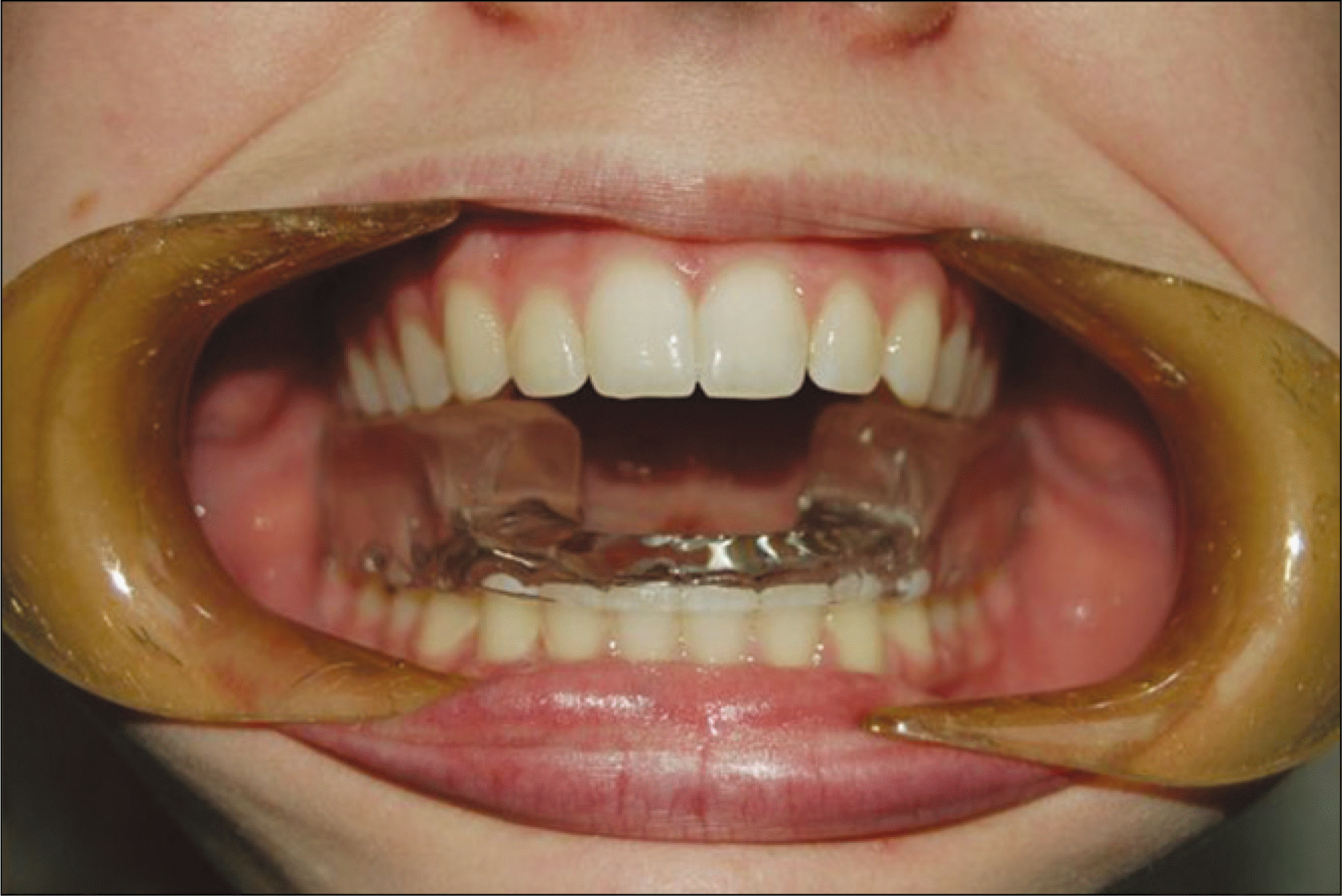Abstract
Introduction
Limited mouth opening is a representative clinical symptom of temporomandibular disorders (TMD) with anterior disc displacement without reduction (ADDWOR). Various treatment methods have been proposed for patients with ADDWOR. This study examined the clinical effectiveness of template therapy for patients with mouth opening difficulty due to the ADDWOR.
Material and Methods
A total of 14 patients (female 12, male 2, average age: 29.1±14.4), who had been treated in the template clinic, Sooncheonhyang University Bucheon Hospital, from January of 2006 to December of 2008, were enrolled in this study. The subjects were selected according to the following criteria: more than 2 weeks after the onset of locking, mouth opening range < 35 mm, and confirmed ADDWOR without a synovial pathology by magnetic resonance imaging (MRI). All patients were treated with the template appliance, instructed to wear it while sleeping and exercise for at least 10 hours per day. The maximum mouth opening (MMO) range and pain recognition scores before and after template therapy were recorded and compared. A paired t-test and Wilcoxon's signed rank test were used for statistical analysis.
Results
After the periodical follow up, significant improvement in the opening range was observed in the template treatment group. The average MMO range before treatment was 30.2±3.5 mm and the average MMO after treatment and follow up was 47.1±4.7 mm. The mean amount of mouth opening increment was 16.9±5.4 mm (P<0.01) and the pain recognition scores before and after treatment was also improved.(P=0.001)
Go to : 
References
1. Japanese Society for Temporomandibular Joint, ed. Temporomandibular joints. Seoul: Narae Publishing;2004.
2. Chung SC, Kim YK. Orofacial pain and temporomandibular disorders. 2nd ed.Seoul: Shinhung Co.;2006.
3. Nitzan DW, Dolwick MF, Martinez GA. Temporomandibular joint arthrocentesis: a simplified treatment for severe, limited mouth opening. J Oral Maxillofac Surg. 1991; 49:1163–7.

4. Park YH, Lee SH, Yoon HJ. An effect of combination with arthrocentesis and stabilization splint treatment on temporomandibular joint disorder patients. J Korean Assoc Plast Reconstr Surg. 2010; 32:32–6.
5. Murakami K, Hosaka H, Moriya Y, Segami N, Iizuka T. Short-term treatment outcome study for the management of temporomandibular joint closed lock. A comparison of arthrocentesis to nonsurgical therapy and arthroscopic lysis and lavage. Oral Surg Oral Med Oral Pathol Oral Radiol Endod. 1995; 80:253–7.
6. Okeson JP. Long-term treatment of disk-interference disorders of the temporomandibular joint with anterior repositioning occlusal splints. J Prosthet Dent. 1988; 60:611–6.

7. Kirk WS Jr, Calabrese DK. Clinical evaluation of physical therapy in the management of internal derangement of the temporomandibular joint. J Oral Maxillofac Surg. 1989; 47:113–9.

8. Chung SC, Kim HS. The effect of the stabilization splint on the TMJ closed lock. Cranio. 1993; 11:95–101.

9. Holmlund AB. Surgery for TMJ internal derangement. Evaluation of treatment outcome and criteria for success. Int J Oral Maxillofac Surg. 1993; 22:75–7.
10. Murakami KI, Iizuka T, Matsuki M, Ono T. Recapturing the persistent anteriorly displaced disk by mandibular manipulation after pumping and hydraulic pressure to the upper cavity of the temporomandibular joint. Cranio. 1987; 5:17–24.
11. Fridrich KL, Wise JM, Zeitler DL. Prospective comparison of arthroscopy and arthrocentesis for temporomandibular joint disorders. J Oral Maxillofac Surg. 1996; 54:816–20.

12. Sanroma ′ n JF. Closed lock (MRI fixed disc): a comparison of arthrocentesis and arthroscopy. Int J Oral Maxillofac Surg. 2004; 33:344–8.
13. Barkin S, Weinberg S. Internal derangements of the temporomandibular joint: the role of arthroscopic surgery and arthrocentesis. J Can Dent Assoc. 2000; 66:199–203.
14. Guthrie PB. Temporomandibular joint arthrocentesis versus arthroscopy. Aust Dent J. 2000; 45:63.
15. Frost DE, Kendell BD, Owsley T. Clinical results of arthrocentesis in 40 cases. Br J Oral Maxillofac Surg. 1992; 30:340.
16. Hosaka H, Murakami K, Goto K, Iizuka T. Outcome of arthrocentesis for temporomandibular joint with closed lock at 3 years follow-up. Oral Surg Oral Med Oral Pathol Oral Radiol Endod. 1996; 82:501–4.

17. Guzay CM. Introduction to the quadrant theorem, Basal Facts. 1976; 1:153–60.
18. Maehara K, Sato S, Takada F, Ito H, Matsui T, Ueda T, et al. A template therapy approach for nonspecific complaints. Basal Facts. 1986; 8:22–35.
19. Guzay CM. Quadrant theorem: a viewable biophysical analysis of prosthodontia, orthodontia, and TMJ disorders. Chicago: D.D.S. Publications;1979.
20. Guzay CM. Quadrant theorem, part 2. Basal Facts. 1977; 2:19–33.
Go to : 
 | Fig. 2.Template appliance, which is located at the posterior segment of occlusal arch, reduces the pressure to the temporomandibular joint according to the 2nd principle of lever action. |
Table 1.
Clinical data of patients treated by template
| Case No. | MMO (mm) | Elapsed time | ||||
|---|---|---|---|---|---|---|
| Before | After | Changes (Δ) | Locking period (W) | Until 40 mm (W) | Overall F/U (M) | |
| 1 | 34 | 46 | 12 | 4 | 4 | 6 |
| 2 | 35 | 52 | 17 | 3 | 2 | 10 |
| 3 | 32 | 46 | 14 | 4 | 1 | 17 |
| 4 | 30 | 44 | 14 | 4 | 4 | 16 |
| 5 | 31 | 47 | 16 | 4 | 4 | 6 |
| 6 | 32 | 53 | 21 | 3 | 2 | 9 |
| 7 | 23 | 50 | 27 | 12 | 1 | 7 |
| 8 | 30 | 55 | 25 | 16 | 24 | 6 |
| 9 | 29 | 45 | 16 | 4 | 24 | 24 |
| 10 | 30 | 44 | 14 | 12 | 4 | 22 |
| 11 | 35 | 47 | 12 | 12 | 16 | 27 |
| 12 | 26 | 37 | 11 | 3 | 12 | 22 |
| 13 | 26 | 51 | 25 | 3 | 20 | 18 |
| 14 | 30 | 43 | 13 | 4 | 8 | 11 |
| Avg | 30.2±3.5 | 47.1±4.7 | 16.9±5.4* | 6.3±4.5 | 10.9±8.6 | 14.3±7.4 |




 PDF
PDF ePub
ePub Citation
Citation Print
Print



 XML Download
XML Download